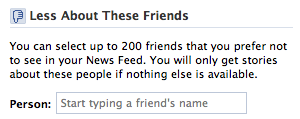A few weeks ago, before winter break and also before certain unfortunate events took place, I wrote a post about “unfriending.” To my delight, this post elicited a number of extremely thoughtful comments. Since I think these comments touch on a lot of wider issues, I wanted to take a moment to address some common themes.
Reactions ranged from “social networks are too different from real life” to “social networks are too similar to real life” to “people should just get real lives.” The funny part is, each of those reactions has some element of truth. Taking them one by one:
1) Social networks are too different from real life.
The first comment came from Ben Turner, who noted that “It seems as though social networking sites shy away from providing real approximations of people’s real relationships with each other.” He then proposed two possible axes along which social networks deviated from the way real life works. The first was the idea that social networks establish strong binary labels, and in fact require them to organize their databases, in a way that real life just doesn’t. You’re not required to “confirm Jacob as a friend” before you can approach Jacob on a street corner to say hello. On some social networks, though, that’s exactly what happens. Likewise, the way you feel about someone changes dynamically over time; on a social network, you make a decision once (“I will let this person into my information sphere”) and then to change that decision requires a radical act. Ben’s suggestion was that, if we saw such simplistic binary representations of relationships and acquaintanceships in real life, things would get ugly very quickly. Somehow, social networks manage to get away with it…but that’s not to say that things don’t sometimes get ugly.
The second axis identified by Ben was the idea that social networks are actually invested in discouraging negative experiences, because negative social experiences cast a pall over the social network itself. (If a messy fight with one of my friends plays out over, say, Twitter, I might be disinclined to use Twitter for a while.) Especially for sites that use your friends’ updates to provide a constant stream of information (see: Facebook’s news feed, Twitter’s home page), the more “friends” the sites can draw from the more information they can stream. And the more a site updates, the more people click “refresh,” with the nice side effect that the ads reload too, and oh! There’s another ad impression, which is definitely good for the bottom line of the social network. This leads to social networks being motivated to establish a low barrier to entry for “friendship,” leading to superficial “friending” and a loose net of online “friends” that may have little to no correlation with any real-world “friends.” For the same reason, most sites don’t notify you when you’ve been unfriended…you just have to go searching for clues yourself. The problem is that, even if the site doesn’t notify you, the concept of “friendship” is so embedded in the way a site works that the fact of unfriendship can’t easily be hidden. Social networks, according to Ben’s analysis, frustrate us because they seem to claim to approximate real life, and yet miss it by a long shot because of the way they’re structured.
2) Social networks are too similar to real life.
In the second comment, Britta Bohlinger suggested that “Now, what we seem to witness online in these days is perhaps nothing more dramatic than what happens offline…And yes, no matter how old you are: if things go wrong or you want to move on, unfriending might be a very healthy thing to do. It implies a moment of thinking, a rather conscious decision.” I definitely agree with this. Maybe what hurts about unfriending on social networks is that it so often does mirror what happens in real life. In the recent Whopper Sacrifice shenanigan on Facebook, where users could unfriend 10 friends (who would then be notified accordingly) and earn a Whopper, the ploy worked precisely because it dealt playfully with traditional expectations. If one of your friends got notice that she had been sacrificed for a Whopper, any sort of grave emotional reaction on her part would probably seem outsized. And likely, you’d add her back at the first opportunity.
In some ways, it’s the fact that these sites don’t notify you when you’re unfriended that makes the practice of unfriending so hurtful. Unfriending is a form of non-communication, which kind of precludes the possibility that it would be done playfully. Since it’s so secretive by design, any discovery of an unfriending has the attendant string of betrayal. “You mean they didn’t even talk to me about it?” With the Sacrifice scheme, since the program let your friend know she’d been unfriended—in a somewhat ludicrous way—it became just another form of communication, out of the realm of passive aggression and betrayal and into the realm of teasing. In real life, people’s intentions and decisions aren’t always on constant display the way they are online, manifested in the user interfaces of social networks. But it wouldn’t hurt to be unfriended on social networks if it didn’t hurt to lose a friendship in real life.
3) People should just get real lives.
A little while later, b cut to the chase. “Being unfriended is like being dropped after having sex on the first date. What were you thinking in the first place? Post less and grow up more.” To which Ryan responded “I agree that removing a friend can be touchy and a sensitive thing, but its necessary sometimes. I had to cancel my time on twitter because of the time I was wasting following people’s tweets. I think that an occasional text message or phone call, or simply catching up with someone when I see them around, is the only way to really go for me. Too much to do.”
Are kids (and adults) overly obsessed with social networks to the detriment of their real-world social lives? This is a question I get asked a lot. Usually, my answer is “in some cases yes, but basically no.”
It’s definitely possible to become too preoccupied with the minute vagaries of friendships and acquaintanceships as represented on social networks. But in the end, they’re just communication mediums like any other. Text messages, phone calls, and Facebook messages are all ways of getting information across distance. And while each has its nuances, no one of them is inherently superior to the others. The difference with social networks might be primarily that they so transparently reveal the social graph, and your place within it. Seeing a visual representation of where you stand in relation to other people can spark our desire to be genuinely recognized, sought-after, admired, or just paid-attention-to. I strongly believe in the importance of facetime. But I also believe that vilifying one medium and elevating another might ultimately distract from the real issue. So many of my online friendships have transitioned into some of my richest real-life friendships; the challenge lies in making the transition from one realm to the other, safely and thoughtfully.
Because here’s the secret: there’s not “fake life” and “real life.” There’s just real life, running through multiple channels. We can switch between them to accomplish different things, but they’re all part of the same whole. Balancing kindness to others with the imperative for self-preservation is hard no matter what, and the answers are never easy. Understanding the ways that all these channels collide and collude is one of the great challenges of the digital age. Fortunately, the same truth that makes social networks compelling and frustrating is the truth that will save us from them and save them for us: as social creatures, we’re all obsessed with our social networks—online or off. It’s how we deal with that obsession, and integrate it into our lives in healthy ways, that matters.












